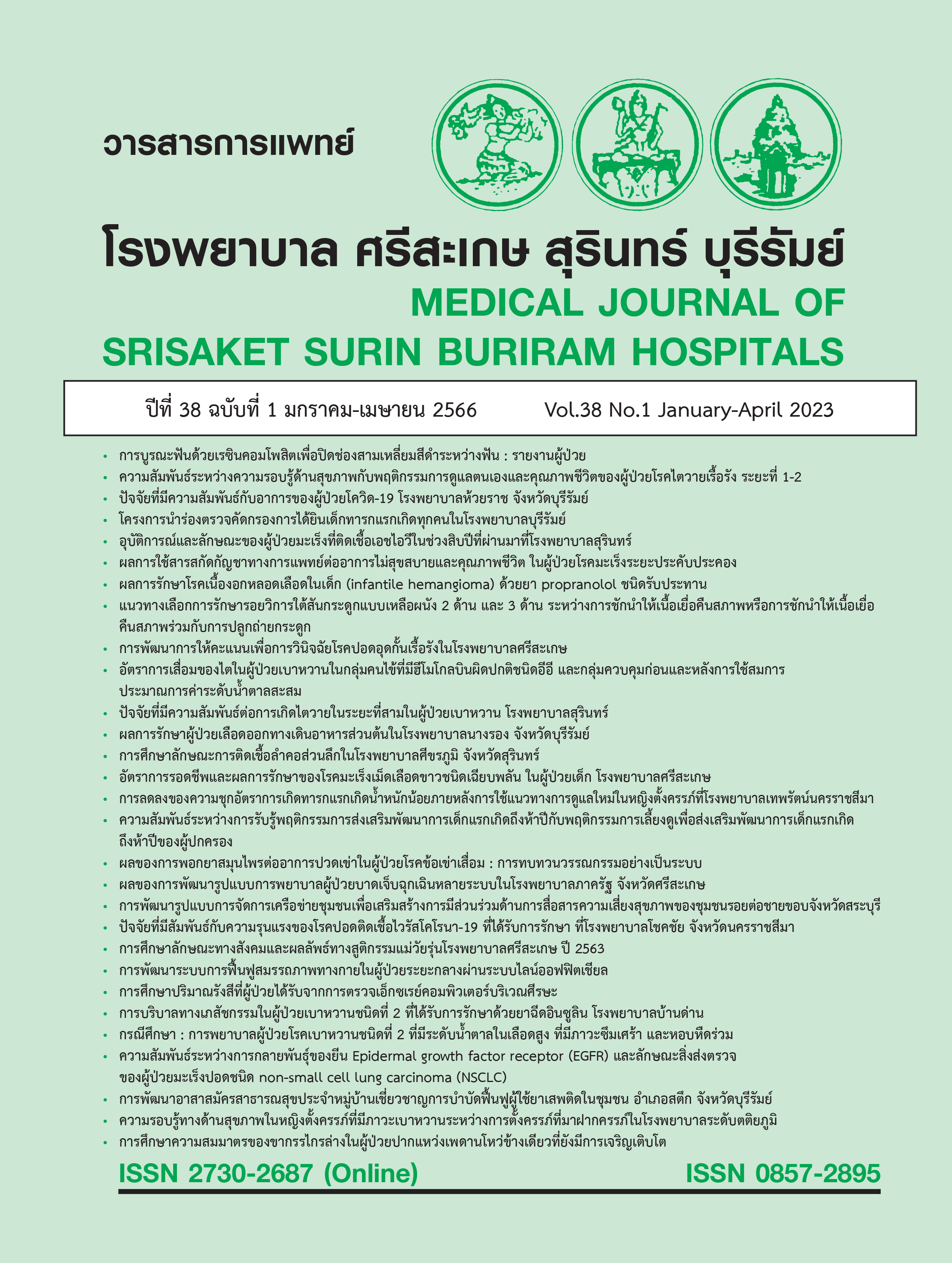อัตราการเสื่อมของไตในผู้ป่วยเบาหวานในกลุ่มคนไข้ที่มีฮีโมโกลบินผิดปกติชนิดอีอี และกลุ่มควบคุม ก่อนและหลังการใช้สมการประมาณการค่าระดับน้ำตาลสะสม
Main Article Content
บทคัดย่อ
เหตุผลของการทำวิจัย: งานวิจัยนี้เป็นการศึกษาอัตราการเสื่อมของไตในผู้ป่วยเบาหวานในกลุ่มคนไข้ที่มีฮีโมโกลบินผิดปกติชนิดอีอี และกลุ่มควบคุม ก่อนและหลังการใช้สมการประมาณการค่าระดับน้ำตาลสะสม
เป้าหมาย: เพื่อชะลอการเสื่อมของไตในกลุ่มคนไข้ที่มีฮีโมโกลบินผิดปกติชนิดอีอีเปรียบเทียบกับกลุ่มควบคุม
วิธีการทำวิจัย: การวิเคราะห์ปัญหาเริ่มต้นงานวิจัยในปี พ.ศ. 2552 มีการรวบรวมข้อมูลอัตราการเสื่อมของไตแบ่งเป็นคนไข้ 2 กลุ่มคือกลุ่มที่มีฮีโมโกลบินผิดปกติชนิดอีอีและกลุ่มควบคุม การวิเคราะห์ข้อมูลจึงเป็นการวิเคราะห์ข้อมูลแบบใช้ข้อมูลในอดีตเป็นการเปรียบเทียบใน 2 กลุ่ม นำข้อมูลความสัมพันธ์ของระดับความเข้มข้นของเลือดและระดับน้ำตาลปลายนิ้วขณะอดอาหารมากกว่า 6 ชั่วโมง มาพัฒนาสมการเพื่อใช้ในการประมาณการค่าระดับน้ำตาลสะสม การนำสูตรหรือสมการที่คำนวณได้นั้นมาใช้ในการควบคุมระดับน้ำตาลของผู้ป่วยในแต่ละบุคคล ตัวชี้วัดหรือผลลัพธ์ที่ใช้ในการประเมินการควบคุมน้ำตาล คืออัตราการเสื่อมของไตต่อ365วัน
ผลการศึกษา: ผู้ป่วยทั้งหมด 566 ราย ร้อยละ32.2 เป็นผู้ชาย และร้อยละ 20.7 เป็นฮีโมโกลบินผิดปกติชนิดอีอี การวิเคราะห์ถดถอยเชิงเส้นตรงพบว่าอัตราการเสื่อมของไตของผู้ป่วยที่มีเม็ดเลือดผิดปกติชนิดอีอีนั้นก่อนปี 2552 พบว่ามีอัตราการเสื่อมของไตเฉลี่ยอยู่ที่ -3.41 หน่วยต่อปีหรือร้อยละ 95 CI: -4.67 ถึง -2.4 ค่า p-value<0.001 เมื่อเปรียบเทียบกับกลุ่มควบคุมนั้น พบว่าผู้ป่วยมีอัตราการเสื่อมของไตอยู่ที่ - 1.88 หน่วยต่อปีร้อยละ 95 CI:- 3.28 ถึง - 0.48 p-value=0.009 และหลังจากที่ผู้วิจัยปรับระดับน้ำตาลผู้ป่วยตามสูตรหรือสมการที่ใช้ในการประมาณการค่าระดับน้ำตาลสะสมตามระดับของความเข้มข้นของเลือด Y=2.5+0.015Dtx+0.06Hct พบว่าผู้ป่วยในกลุ่มของผู้ป่วยที่มีเม็ดเลือดผิดปกติชนิดอีอีนั้น มีอัตราการเสื่อมของไตอยู่ที่ 1.35 และ 0.097 หน่วยต่อปีหรือร้อยละ 95 CI: - 0.58 ถึง 3.29 p-value=0.169 และร้อยละ 95 CI: - 0.66 ถึง 0.44 p-value=0.737 ตามลำดับ
สรุป: ผู้ป่วยฮีโมโกลบินอีอี โรงพยาบาลสุรินทร์มีเป้าหมายในการควบคุมน้ำตาลในเลือดที่แตกต่างกันไปตามระดับของความเข้มข้นของเลือด
Article Details

อนุญาตภายใต้เงื่อนไข Creative Commons Attribution-NonCommercial-NoDerivatives 4.0 International License.
เอกสารอ้างอิง
World Health Organization. The World Health Organization Report. WHO: Geneva, Switzerland; 2021.
International Diabetes Federation. IDF Diabetes Atlas 2021. [Internet]. 2021. [cited 2022 Jan 21]. Available from:URL: https://diabetesatlas.org/atlas/tenth-edition/
[No authors listed]. Intensive blood-glucose control with sulphonylureas or insulin compared with conventional treatment and risk of complications in patients with type 2 diabetes (UKPDS 33). UK Prospective Diabetes Study (UKPDS) Group. Lancet. 1998;352(9131):837-53.PMID: 9742976
Diabetes Control and Complications Trial Research Group; Nathan DM, Genuth S, Lachin J, Cleary P, Crofford O, et al. The effect of intensive treatment of diabetes on the development and progression of long-term complications in insulin-dependent diabetes mellitus. N Engl J Med 1993;329(14):977-86. doi: 10.1056/NEJM199309303291401.
American Diabetes Association. Standards of Medical Care in Diabetes 2021. Diabetes Care December 2020;44:S1-S2. doi:https://doi.org/10.2337/dc21-Sint
de Boer IH, Khunti K, Sadusky T, Tuttle KR, Neumiller JJ, Rhee CM, et al. Diabetes Management in Chronic Kidney Disease: A Consensus Report by the American Diabetes Association (ADA) and Kidney Disease: Improving Global Outcomes (KDIGO). Diabetes Care 2022;45(12):3075-90. doi: 10.2337/dci22-0027.
Winocour PH. Effective diabetes care: a need for realistic targets. BMJ 2002;324(7353):1577-80. doi: 10.1136/bmj.324.7353.1577.
Eliasson B, Cederholm J, Nilsson P, Gudbjörnsdóttir S; Steering Committee of the Swedish National Diabetes Register. The gap between guidelines and reality: Type 2 diabetes in a National Diabetes Register 1996-2003. Diabet Med 2005;22(10):1420-6. doi: 10.1111/j.1464-5491.2005.01648.x.
Bryant W, Greenfield JR, Chisholm DJ, Campbell LV. Diabetes guidelines: easier to preach than to practise? Med J Aust 2006;185(6):305-9. doi: 10.5694/j.1326-5377.2006.tb00583.x.
เฉลียว สัตตรัตนามัย, สิริลักษณ์ ทองสุทธิ์, ปัญญาพร สุจริตชืพ, เดือนรุ้ง ถึงแสง, สุรสิทธ์ ชมชื่น. ความชุกของธาลัสซีเมียและฮีโมโกลบินผิดปกติ ในหญิงตั้งครรภ์โรงพยาบาลศูนย์สุรินทร์. วารสารการแพทย์โรงพยาบาลศรีสะเกษ สุรินทร์ บุรีรัมย์ 2543;15(1):1-12.
NGSP. Factors that interfere with HbA1c test results. [Internet]. Updated 06/17/2022 [cited 2022 Jan 21]. Available from:URL: NGSP: Factors that Interfere with HbA1c Test Results
Nathan DM, Kuenen J, Borg R, Zheng H, Schoenfeld D, Heine RJ, et al. Translating the A1C assay into estimated average glucose values. Diabetes Care 2008;31(8):1473-8. doi: 10.2337/dc08-0545.
Sacks DB. A1C versus glucose testing: a comparison. Diabetes Care 2011;34(2):518-23. doi: 10.2337/dc10-1546.
Selvin E, Crainiceanu CM, Brancati FL, Coresh J. Short-term variability in measures of glycemia and implications for the classification of diabetes. Arch Intern Med 2007;167(14):1545-51. doi: 10.1001/archinte.167.14.1545.
International Expert Committee. International Expert Committee report on the role of the A1C assay in the diagnosis of diabetes. Diabetes Care 2009;32(7):1327-34. doi: 10.2337/dc09-9033.
NGSP. Factors that interfere with HbA1c test results. [Internet]. [cited 2022 Jan 21]. Available from:URL: NGSP: Factors that Interfere with HbA1c Test Results
ภัสสร สื่อยรรยงศิริ. ปัจจัยทางด้านฮืโมโกลบินผิดปกติ ชนิดอี ที่มีผลต่อการวัดระดับน้ำตาลสะสมในผู้ป่วยเบาหวาน. วารสารโรงพยาบาลศรีสะเกษ สุรินทร์ บุรีรัมย์ 2551;23(2): 637-643.
Sueyanyongsiri P., Tangbundit P., Sueyanyongsiri S., Bunmee S., Khansri P. Artifactually Low Hemoglobin A1C in Diabetic Patients with Hemoglobin E Disorder: Surin Hospital, Thailand. Allergy drugs clin immunol 2019;3:117. Corpus ID: 212595460
Sueyanyongsiri P. Decline of Renal Function Stratified by Hematocrit Level in Hemoglobin E diabetic patients in Surin hospital, Thailand. [Internet]. [cited 2022 Jan 21]. Available from:URL: Decline of Renal Function Stratified by Hematocrit Level in Hemoglobin E diabetic patients in Surin hospital, Thailand (morressier.com)
Action to Control Cardiovascular Risk in Diabetes Study Group; Gerstein HC, Miller ME, Byington RP, Goff DC Jr, Bigger JT, et al. Effects of intensive glucose lowering in type 2 diabetes. N Engl J Med 2008;358(24):2545-59. doi: 10.1056/NEJMoa0802743.
Prayongratana K, Polprasert C, Raungrongmorakot K, Tatone K, Santiwatanakul S. Low cost combination of DCIP and MCV was better than that of DCIP and OF in the screening for hemoglobin E. J Med Assoc Thai 2008 Oct;91(10):1499-504. PMID: 18972891
VAN DONGEN S., MOLENBERGHS G., MATTHYSEN E. The statistical analysis of fluctuating asymmetry: REML estimation of a mixed regression model. J EVOL BIOL 1999;12:94-102. https://doi.org/10.1046/j.1420-9101.1999.00012.x


